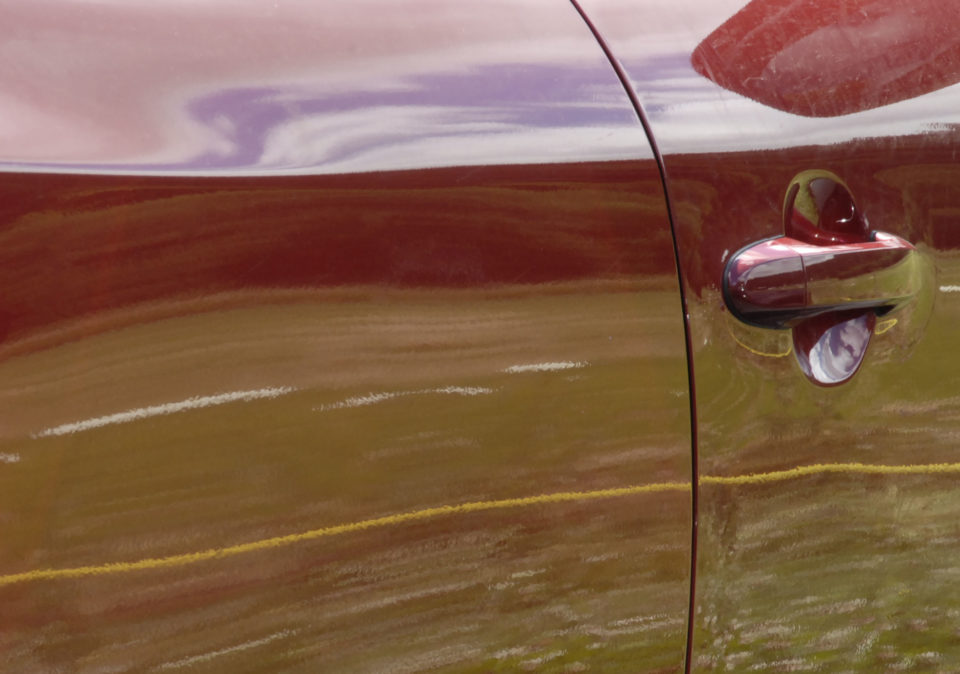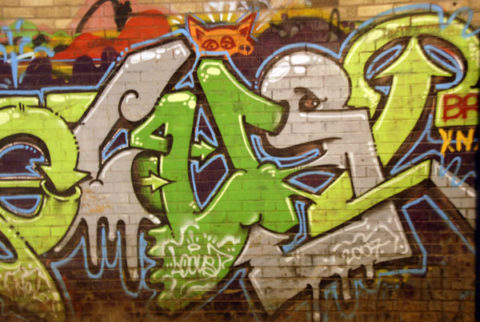Dictionary.com defines the word “abstract” as “thought of apart from concrete realities, specific objects, or actual instances; difficult to understand.”
During my recent vacation, I had the chance to visit three places that were all very different but had this common thread of abstract art. I adore doing abstractions in photography, as you can see from the image above of reflections in a car door.
Bear with me and then tell me what you think of the connections I found.
First, two friends and I visited the Evergreen Brickworks in Toronto, a place that teaches about sustainable living in cities.
The building was the former Don Valley Brickworks which went out of business and sat in disrepair for many years. It is covered with graffiti, which the developers of the site kept as is.
I’m fascinated by the art and expressiveness of graffiti, and how it is perceived differently in many parts of the world.
After we left the Brickworks, my friends and I visited the Art Gallery of Ontario, where there was an exhibit of Abstract Expressionist paintings from several artists who banded together in Greenwich Village in the 1940’s and 50’s; artists like Willem de Kooning, Mark Rothko, Jackson Pollock, Joan Mitchell, Robert Motherell, etc.
They used the canvas as “an arena in which to act” rather than as a place to produce an object. In his famous 1952 essay, “The American Action Painters,” art critic Harold Rosenberg wrote, “What was to go on the canvas was not a picture but an event.”
In looking at their work, I was suddenly struck by the similarity between these paintings (all considered masterpieces) and the graffiti we’d seen at the Brickworks. For example, see Arshile Gorky’s take on Garden in Sochi.
Compare my car door at the top of this post to Mark Rothko’s, No.5/No.22 1950. Okay, I’m no Mark Rothko, but the colouring and lines are similar.
Later in the week, I visited the Royal Ontario Museum in Toronto, mostly to see their fantastic exhibit on water. However, I was thrilled to discover that they also had an exhibit by one of my favourite environmental photographers, Ed Burtynsky. His exhibit follows the rise and impact and eventual fall of the oil industry, as seen by large-scale, sometimes aerial photographs.
When I got to his section on the end of oil, this image of Densified Oil Filters blew me away with its similarity to the work of the abstract expressionists, especially this one by Jackson Pollock, Number 1A, 1948.
Often, when we look at abstract or contemporary work, we attempt to understand what the artist is saying, and we can’t do it. What I learned from these exhibits is that this type of art is not meant to be understood with the rational mind, but experienced with the heart.
As Franz Kline, one of the abstract expressionists said,
“I paint not the things I see but the feelings they arouse in me.”
Do you see the connections? How do you feel about abstract art?


Kim,
Great post! I was excited for several reasons. One: we are planning a visit to Toronto in late Sept – all of the above will now be on my list of things-to-do.
I just wrote a post about experiencing the art of others for Kat Sloma’s “Find Your Eye” course. I feel that my photography has been moving in an abstract direction and enjoyed reading your explanations of the art form.
Thanks, Brenda. Glad it connected with you. I do love your abstract art and will be reading your post now. Do visit those exhibits in Toronto if they are still there!
I have been thinking about art deeply since the AGO show. I love the connection between graffiti and expressionism, I especially love Helen Frankenthaler.
And I quote her: ” When I say gesture, my gesture, I mean what my mark is. I think there is something now I am still working out in paint; it is a struggle for me to both discard and retain what is gestural and personal, “Signature.”.
In my heart graffiti is your signature in gesture.
I love that word, gestural. Thanks for sharing that magical day with me.
Great Post! I completely agree that is a striking connection between Abstract Expressionism and most styles of graffiti. Often times as well murals, frescos, and graffiti share similar stylistic tendencies. I very much like taking pictures of graffiti. If you like, I could show you some from the trip Michelle and I took in Eastern Europe.
Nice to see you here, Emily! Yes, I would love to see pictures you took of graffiti. Do you have them on Facebook? Did you see the Lennon wall in Prague?
I’m glad I found you here! They are not on facebook, but when I make an album of them I will let you know! Unfortunately I didn’t get to Prague so if you have a picture of the Lennon Wall I’d love to see it.
Do you mind if I quote a few of your posts as long
as I provide credit and sources back to your
weblog? My blog is in the very same niche as yours and my users would definitely
benefit from some of the information you present here.
Please let me know if this okay with you. Regards!
Certainly. Thank you for asking.
I love that car door abstract! There’s such a lovely flow to the reflections.